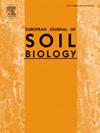The hidden shift: The role of exotic plantations in modulating soil arthropod communities in an arid island
IF 3.3
2区 农林科学
Q1 ECOLOGY
引用次数: 0
Abstract
Reforestation with exotic species has often been used in arid and semiarid areas to restore degraded ecosystems. However, the effects of these plantations on soil biodiversity are still under debate. In the present study, we aimed to evaluate the long-term impacts (>60 years) of exotic plantations with Acacia cyclops and Pinus halepensis on soil biodiversity in an insular arid ecosystem of high ecological value. To do so, we study soil quality and soil arthropod communities in patches of vegetation under uniform edaphoclimatic conditions. Soil quality assessment was carried out by developing an ad-hoc Soil Quality Index (SQI) across seven sites, including two plantations (Pinus or Acacia), two degraded areas with a low cover of native species, and three sites with a high cover of native species. Whole organism community DNA (wocDNA) metabarcoding and barcoding were used to analyse key soil arthropod groups (Coleoptera, Acari and Collembola) recognized as habitat quality and biodiversity indicators. Our findings show that exotic plantations improved soil quality compared to degraded sites, with a considerable increase in the organic carbon pool, macronutrients and microbiological activity (SQI = 0.53 ± 0.12 vs. 0.29 ± 0.06). This improvement did not reach the values recorded in soils with a high cover of preserved native flora (SQI = 0.65 ± 0.12), with some exceptions. Richness of mesofauna and Coleoptera was lower in degraded areas (4.4 ± 1.6 and 0.4 ± 0.7, respectively) followed by exotic plantations (9.5 ± 2.6 and 1.2 ± 0.9) and permanent native vegetation (14.1 ± 5.5 and 2.2 ± 1.8). Soil quality significantly explained up to 52 % and 17 % of the variance in the richness of mesofauna and Coleoptera, respectively. While exotic plantations appear to prevent further land degradation in terms of soil quality, multivariate analysis shows that the structure of soil arthropod communities, particularly in Pinus plantations and to a lesser extent in Acacia plantations, differs significantly from that of soils in ecosystems with remnant native flora. These results highlight the need for a careful balance between biodiversity conservation and soil health management, especially in areas susceptible to desertification.

隐藏的转变:外来人工林在干旱岛屿调节土壤节肢动物群落中的作用
在干旱和半干旱地区,利用外来物种造林是恢复退化生态系统的常用方法。然而,这些人工林对土壤生物多样性的影响仍存在争议。在本研究中,我们旨在评估在一个具有高生态价值的孤岛干旱生态系统中,种植刺槐和halepensis的外来人工林对土壤生物多样性的长期影响(>60)。为此,我们研究了均匀气候条件下植被斑块的土壤质量和土壤节肢动物群落。通过建立特别土壤质量指数(SQI)对7个样地进行土壤质量评价,包括2个人工林(松木或金合欢)、2个原生物种低覆盖的退化区和3个原生物种高覆盖的样地。采用全生物群落DNA (wocDNA)元条形码法和条形码法对土壤节肢动物主要类群(鞘翅目、蜱螨和线虫)进行生境质量和生物多样性指标分析。结果表明,与退化地相比,外来人工林改善了土壤质量,有机碳库、常量营养素和微生物活性显著增加(SQI = 0.53±0.12比0.29±0.06)。除了一些例外情况,这种改善没有达到高原生植物覆盖土壤的SQI值(0.65±0.12)。退化区中低等动物和鞘翅目动物的丰富度依次为4.4±1.6和0.4±0.7,其次为外来人工林(9.5±2.6和1.2±0.9)和永久原生植被(14.1±5.5和2.2±1.8)。土壤质量对中、鞘翅目动物丰富度差异的解释分别高达52%和17%。虽然从土壤质量的角度来看,外来人工林似乎可以防止土地进一步退化,但多变量分析表明,土壤节肢动物群落的结构,特别是在松林和金合欢人工林(在较小程度上),与有残余本地植物群的生态系统的土壤结构存在显著差异。这些结果强调需要在生物多样性保护和土壤健康管理之间取得谨慎的平衡,特别是在易受荒漠化影响的地区。
本文章由计算机程序翻译,如有差异,请以英文原文为准。
求助全文
约1分钟内获得全文
求助全文
来源期刊

European Journal of Soil Biology
环境科学-生态学
CiteScore
6.90
自引率
0.00%
发文量
51
审稿时长
27 days
期刊介绍:
The European Journal of Soil Biology covers all aspects of soil biology which deal with microbial and faunal ecology and activity in soils, as well as natural ecosystems or biomes connected to ecological interests: biodiversity, biological conservation, adaptation, impact of global changes on soil biodiversity and ecosystem functioning and effects and fate of pollutants as influenced by soil organisms. Different levels in ecosystem structure are taken into account: individuals, populations, communities and ecosystems themselves. At each level, different disciplinary approaches are welcomed: molecular biology, genetics, ecophysiology, ecology, biogeography and landscape ecology.
 求助内容:
求助内容: 应助结果提醒方式:
应助结果提醒方式:


